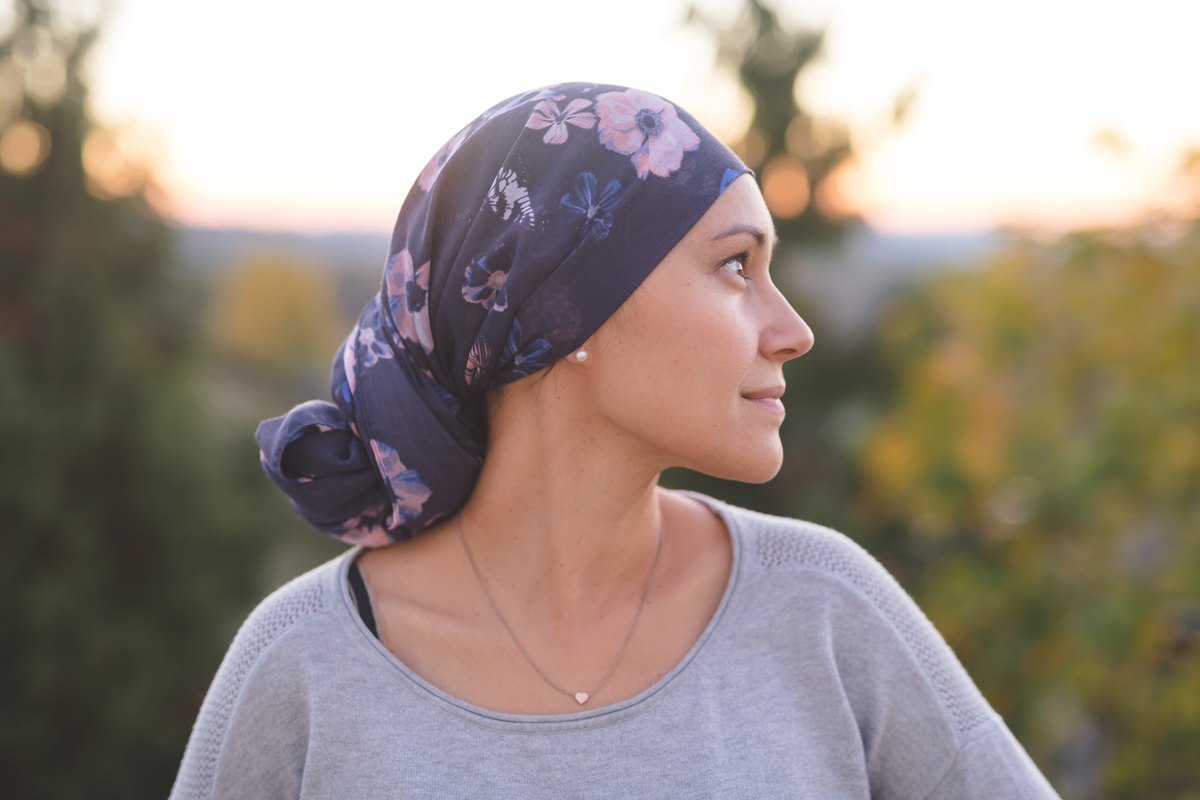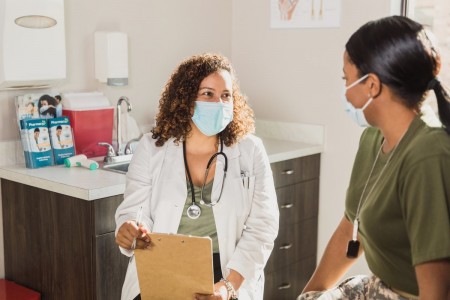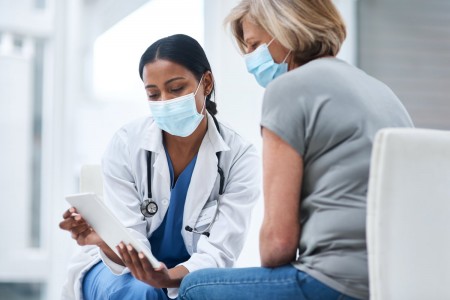
Advertisements
Breast cancer. Second to skin cancer, it's the most common type of cancer in people assigned female at birth (AFAB) in the U.S., according to the American Cancer Society (ACS).
Video of the Day
Statistically speaking, if eight people AFAB are in a room together, one of them will have breast cancer in their lifetime. Knowing these odds, along with who is most likely to get this cancer type, can help us better understand the disease and how best to treat and prevent it.
Worldwide Prevalence of Breast Cancer
Breast cancer is now the most commonly diagnosed cancer worldwide for people AFAB, overtaking lung cancer in 2020 (though lung cancer remains the top newly diagnosed cancer for people assigned male at birth), according to a December 2020 report by the International Agency for Research on Cancer (IARC), part of the World Health Organization.
That IARC report found the following:
- In 2020, 1 in 8 cancers diagnosed worldwidewas breast cancer.
- This cancer type accounts for 1 in 4 cancercases globally for people AFAB.
- Breast cancer in people AFAB accounts for nearly 12 percent ofall new annual cancer cases around the world.
- Breast cancer ranks first in terms of incidenceand mortality in most countries around the world.
By Region and Country
The incidence of breast cancer varies by region. For example, according to a November 2019 article in La Presse Médicale and an April 2019 article in Breast Cancer: Targets and Therapy, the incidence for breast cancer in these regions is:
- Central-East Asia and Africa: 27 out of 100,000
- Australia and Western Europe: 85 to 94 out of 100,000
- North America: 92 out of 100,000
Taking a closer look, here are some stats by country in those regions:
- Nearly 24 percent of all breast cancer cases occur inthe Asia-Pacific region, according to the Breast Cancer: Targets and Therapy article.
- The highest rates for breast cancer in thatregion are in China, Japan and Indonesia, according to the same article.
- France has the highest rate of breast cancer inEurope, reports the La Presse Médicale article.
Breast Cancer in the U.S.
Next, we'll break down the numbers in the U.S. as a whole before we look at new case rates state-by-state.
In 2021, an estimated 281,550 new cases of invasive breast cancer will be diagnosed in people AFAB, according to the National Cancer Institute's (NCI) Surveillance, Epidemiology, and End Results Program (SEER).
Approximately 49,290 new cases of non-invasive,or ductal carcinoma in situ (DCIS), female breast cancer will be diagnosed in2021, according to the ACS.
Excluding skin cancers, breast cancer is estimatedto be the most common cancer diagnosed in the U.S. in 2021, the SEER reports.
Nearly 15 percent of all new cancer cases diagnosed in theU.S. are breast cancer, according to the latest SEER stats.
The incidence rates of breast cancer have increasedby 0.5 percent per year, according to the ACS.
By State
Here's a breakdown of new cases of breast cancer in people AFAB by state (including Washington, D.C.), along with a look at how many people per 100,000 were diagnosed in the year 2018, according to the most recent stats from U.S. Cancer Statistics (USCS), The Official Federal Cancer Statistics from the Centers for Disease Control and Prevention (CDC). It's important to look at both numbers, because you'll see that Florida had the highest number of new cases at 17,823, but Hawaii had the highest incidence rate, with 146 per 100,000 people diagnosed.
- Alabama: 3,816 new cases; 120 per 100,000
- Alaska: 459 new cases; 124 per 100,000
- Arizona: 4,998 new cases; 111 per 100,000
- Arkansas: 2,367 new cases; 125 per 100,000
- California: 27,781 new cases; 121 per 100,000
- Colorado: 4,229 new cases; 130 per 100,000
- Connecticut: 3,245 new cases; 136 per 100,000
- Delaware: 910 new cases; 138 per 100,000
- District of Columbia: 515 new cases; 140 per 100,000
- Florida: 17,823 new cases; 119 per 100,000
- Georgia: 8,174 new cases; 131 per 100,000
- Hawaii: 1,311 new cases; 146 per 100,000
- Idaho: 1,327 new cases; 131 per 100,000
- Illinois: 10,439 new cases; 133 per 100,000
- Indiana: 5,200 new cases; 126 per 100,000
- Iowa: 2,653 new cases; 136 per 100,000
- Kansas: 2,313 new cases; 133 per 100,000
- Kentucky: 3,660 new cases; 128 per 100,000
- Louisiana: 3,775 new cases; 133 per 100,000
- Maine: 1,217 new cases; 125 per 100,000
- Maryland: 4,950 new cases; 130 per 100,000
- Massachusetts: 5,620 new cases; 128 per 100,000
- Michigan: 8,268 new cases; 127 per 100,000
- Minnesota: 4,559 new cases; 135 per 100,000
- Mississippi: 2,343 new cases; 126 per 100,000
- Missouri: 4,822 new cases; 123 per 100,000
- Montana: 985 new cases; 145 per 100,000
- Nebraska: 1,540 new cases; 137 per 100,000
- Nevada: Fewer than 16 new cases; numbers by 100,000 notreported
- New Hampshire: 1,288 new cases; 140 per 100,000
- New Jersey: 7,855 new cases; 137 per 100,000
- New Mexico: 1,474 new cases; 109 per 100,000
- New York: 16,892 new cases; 136 per 100,000
- North Carolina: 9,201 new cases; 139 per 100,000
- North Dakota: 538 new cases; 127 per 100,000
- Ohio: 9,832 new cases; 129 per 100,000
- Oklahoma: 2,933 new cases; 123 per 100,000
- Oregon: 3,624 new cases; 134 per 100,000
- Pennsylvania: 11,186 new cases; 130 per 100,000
- Rhode Island: 1,024 new cases; 145 per 100,000
- South Carolina: 4,295 new cases; 128 per 100,000
- South Dakota: 653 new cases; 126 per 100,000
- Tennessee: 5,316 new cases; 124 per 100,000
- Texas: 17,796 new cases; 116 per 100,000
- Utah: 1,688 new cases; 117 per 100,000
- Vermont: 552 new cases; 130 per 100,000
- Virginia: 6,519 new cases; 124 per 100,000
- Washington: 5,874 new cases; 131 per 100,000
- West Virginia: 1,537 new cases; 121 per 100,000
- Wisconsin: 4,964 new cases; 136 per 100,000
- Wyoming: 404 new cases; 116 per 100,000
Breast Cancer Demographics
This all naturally leads us to: Who gets breast cancer? And more specifically, what population is most affected by breast cancer? Here are some answers.
By Age
Below is a look at how common breast cancer is by age, according to SEER, unless otherwise specified.
Advertisements
- 63 years old is the median age at diagnosis for breast cancer in people AFAB in the U.S.
- The age of most frequent diagnosis in the U.S. is between 65 and 74, and people in this age group account for 26 percent of all new cases.
- Nearly 26 percent of new cases of breast cancer in people AFAB werediagnosed in those ages 55 to 64.
- Just 1.9 percent of new cases werediagnosed in people AFAB ages 20 to 34.
- People AFAB between the ages of 15 and 39 are less likely to bediagnosed at an early stage of breast cancer (47 percent) compared to those older than65 (68 percent), possibly because most breast cancer screening doesn't start until age40, unless that person is at higher risk, according toCancer.Net, a site powered by the American Society of Clinical Oncology.
By Race and Ethnicity
Here's a look at what race has the highest breast cancer rate and which ethnicity group is affected most by the disease, according to October 2019 results in CA: A Cancer Journal for Clinicians, the ACS's peer-reviewed medical journal:
- White adults: 130.8 per 100,000
- Black adults: 126.7 per 100,000
- Hispanic adults: 93.7 per 100,000
- American Indian/Alaskan Native adults: 94.7 per 100,000
- Asian/Pacific Islanders: 93.2 per 100,000
In more detail:
- Before the age of 40, Black people AFAB have thehighest breast cancer incidence rate.
- Disparities in breast cancer incidence andmortality are largest in young people AFAB and decline with age; for instance, the deathrate for Black adults is 1.9 to 2.6 times higher than for white adults in those 50 and younger, but 1.1 to 1.2 times higher in those ages 70 and older.
- Black, Hispanic and AmericanIndian/Alaskan Native patients are less likely to be diagnosed with local-stagebreast cancers (56 to 60 percent) compared with Asian/Pacific Islander and white patients (64 to 66 percent).
- About 8 percent of Black patients are diagnosed withdistant-stage (metastatic) breast cancer, compared with 5 to 6 percent of patients ofother races and ethnicities.
- Black people AFAB are most likely to be diagnosed withtumors that are equal to or greater than 5 cm (12 percent) or high grade (42 percent), and they are the only group forwhich high-grade tumors are more common than low-grade or intermediate-gradetumors.
Related Reading
Black Women Are More Likely to Die From Breast Cancer, and the Mortality Gap Is Getting Worse. Here’s How We Fix That
By Breast Cancer Type
Breast cancer is a complex disease with more than 20 subtypes, but here, we'll focus on stats concerning the stages of progression (0 through 4) along with SEER's three stages: localized, regional and distant.
- Roughly 20 percent of all breast tumors in people AFAB are insitu breast cancer (DCIS), according to 2015 data from the ACS.This type typically begins in a milk duct and hasn't yet spread to other breasttissue, according to the ACS.It's considered stage 0, or non-invasive.
- Of those in situ tumors, about 83 percent are DCIS,while 12 percent will be lobular carcinoma in situ (LCIS), also called lobularneoplasia (abnormal cells not considered cancer), the ACS reports.
- About 80 percent of breast cancers are invasive, according tothe ACS.
- About 64 percent of people AFAB with breast cancer are diagnosed withinvasive breast cancer located only in the breast, or stage 1/local stage, theACS reports.
- Stages 2 and 3, or regional stage disease, are also in thebreast but have spread to nearby lymph nodes (the severity of the stage can bedetermined by the degree of that spread). Stage 3 tumors can also grow into nearbytissues like the skin over the breast or the muscle underneath. About 27 percent of people with the disease have regionalstage breast cancer, according to the ACS.
- Just 6 percent of people have metastatic breast cancer atdiagnosis, according to Cancer.Net.This is considered stage 4 breast cancer, or when this cancer type has spreadbeyond the breast and nearby lymph nodes to other parts of the body, accordingto the ACS.
- Of the some 150,000+ breast cancer survivors wholive with metastatic disease, three-quarters were originally diagnosed with the disease in stages 1, 2 or 3, according to the ACS.
By Sex
While breast cancer is more common in people AFAB, people assigned male at birth (AMAB) can also get the disease.
- People AMAB can have the following types of breast cancer, according to the NCI: infiltrating ductal carcinoma, DCIS, inflammatory breast cancer and Paget disease of the nipple. They have not been reported to have LCIS.
- In 2021, approximately 2,650 people AMAB will bediagnosed with breast cancer in the U.S., according to Cancer.Net.(Remember, that's in contrast to SEER data that estimated 281,550 people AFAB will be diagnosed the same year with invasive femalebreast cancer.)
- Less than 1 percent of all cases of breast cancer occurin people AMAB, according to the NCI,or 1 out of every 100 cases diagnosed, according to the CDC.
- Black people AMAB have the highest incidence rates ofbreast cancer (2.7 out of every 100,000), Cancer.Net reports.
- White people AMAB have the next highest incidence rates (1.9out of every 100,000), according to Cancer.Net.
Stats on Breast Cancer Risk Factors
Knowing the statistics around female breast cancer risk factors can help us understand what might affect our chance of having this cancer type. Here are just some of those statistics, from BreastCancer.org.
- For people AFAB, the risk of breast cancer almost doublesif you have a first-degree relative who'sbeen diagnosed with breast cancer, including a mother, sister or daughter.
- Less than 15 percent of people AFAB diagnosed with breastcancer have a family member also diagnosed with the disease.
- About 5 to 10 percent of breast cancers are linkableto known gene mutations inherited from a person's parents.
- BRCA1 and BRCA2 gene mutations are the mostcommon genetic mutations that cause breast cancer. Case in point: Someone witha BRCA1 mutation, on average, has up to a 72 percent lifetime risk of developingbreast cancer, while someone with the BRCA2 mutation has a 69 percent risk.
- Breast cancers with the BRCA1 or BRCA2 mutation tendto develop most commonly in younger women.
- These genetic mutations also come with an increasedovarian cancer risk.
- For people AMAB, BRCA2 mutations are associated with alifetime breast cancer risk of about 6.8 percent; BRCA1 mutations don't cause breastcancer as commonly in people AMAB.
- About 85 percent of breast cancers occur in people AFAB whohave no family history of breast cancer.
Breast Cancer Mortality and Survival Rates
While there are currently more than 3.8 million people living with breast cancer (some cancer-free, some still with evidence of cancer, some undergoing treatment) in the U.S., according to the ACS, breast cancer can lead to death. First, we'll examine the breast cancer mortality rate with this cancer type, and then we'll look at some more uplifting stats.
Worldwide Breast Cancer Mortality
- Breast cancer is the fifth-leading cause ofcancer mortality worldwide, with 685,000 deaths in 2020, according to the IARC.
- This cancer type accounts for 1 in 6 cancerdeaths in people AFAB, the IARC reports.
U.S. Breast Cancer Mortality
- 1 in 39 people AFAB (3 percent) will die from breast cancerin the U.S., according to the ACS.
- An estimated 43,600 people will die of female breastcancer in 2021, according to SEER data.
- An estimated 530 people AMAB will die from breast cancerin 2021, according to Cancer.Net.
- Black people AFAB have the highest breast cancer deathrate (28.4 per 100,000). That's 40 percent higher than white people AFAB (20.3 per 100,000)and more than double the rate in API people AFAB (11.5 per 100,000), according to CA: A Cancer Journal for Clinicians.
- Black people AFAB are most likely to die from breastcancer at every age, according to the CA: A Cancer Journal for Clinicians article.
Breast Cancer Survival Rates
The female breast cancer survival rates change by severity of the cancer type at diagnosis. In addition, breast cancers are staged by the three SEER stages, so survival rates are not broken down by numbered stages, like you might expect. Here are those numbers.
- The average five-year survival rate for people AFAB withnon-metastatic invasive breast cancer, of all three SEER stages combined, is 90 percent, according to Cancer.Net. (The five-year survival rate is how many peoplelive at least five years after cancer is found.)
- The average 10-year survival rate for people AFAB withnon-metastatic invasive breast cancer is 84 percent, according to Cancer.Net. (That's the percentage of peoplestill alive at least 10 years after diagnosis.)
- The average five-year survival rate for DCIS is 100 percent, accordingto the National Breast Cancer Foundation.
- If female breast cancer is located only in the breast, or is "localized," the five-year survival rate is 99 percent, Cancer.Netreports.
- If the disease has spread to nearby lymph nodes, or is "regional," the five-year survival rate is 86 percent, according to Cancer.Net.
- If female breast cancer has spread beyond the lymph nodes, or is "distant," the five-year survival rate is 28 percent. This is also called metastaticbreast cancer, according to Cancer.Net.
- The cancer type called triple-negative breast cancer, anaggressive form of invasive breast cancer that accounts for about 10 to 15 percent ofall breast cancers, according to the ACS,has different survival rates. The average five-year survival rate for this cancertype with all stages combined is 77 percent. For localized disease, it's 91 percent; regional,65 percent; and distant, 12 percent.
- Inflammatory breast cancer, whichaccounts for up to 5 percent of all breast cancers, is an aggressive form of thedisease also with different survival rates, according to the ACS.The average five-year survival rate of the two SEERs stages is 41 percent; for regionaldisease, it's 56 percent; and for distant, it's 19 percent.
- Survival rates are about 9 to 10 percent lower in Black compared to white people AFAB, Cancer.Net reports.
- The breast cancer death rate increased by 0.4 percent per yearfrom 1975 to 1989, but since then has seen an incredibledecrease, at a total decline of 40 percent through 2017, according to the CA: A Cancer Journal for Clinicians article.
- Because of this rapid decline in the death rate, anestimated 375,900 breast cancer deaths have been preventedin women in the U.S. through 2017, that same article reports.
Breast Cancer Screening Stats
Both treatment innovations and early detection of breast cancer by mammography have helped drive down breast cancer mortality rates, the CA: A Cancer Journal for Clinicians article reveals. Here are some stats on breast cancer screening from that same article:
- In the 1980s and 1990s, DCISand invasive breast cancer incidence rates increased significantly, especially inpeople AFAB ages 50 and older. This is largely due to the increased use of mammographyscreening detecting the cases.
- Mammography screening increasedfrom 29 percent in 1987 to 70 percent in 2000.
- In ranges by state, thereported prevalence of up-to-date screening according to the ACS' guideline (whichis annual screening for women ages 45 to 54 and biennial screening for those55 and older) in 2016 ranged from 57 percent in Wyoming to 79 percent in Rhode Island.
- For biennial mammographyamong women ages 50 to 74 (according to screening recommendations from the U.S. Preventative Services Task Force), the prevalence ranged from 64 percent in Idaho andWyoming to 86 percent in Connecticut and Massachusetts.
Breast Cancer Treatment by the Numbers
Recent treatment advances, including the identification of genetic changes in breast cancer tumors, could lead to more targeted breast cancer treatment and continue to save lives. This is what the CA: A Cancer Journal for Clinicians article published about breast cancer treatment:
- Nearly half ofpatients with early stage (stage 1 or 2) breast cancer underwentbreast-conserving surgery with adjuvant radiation therapy, and one-thirdunderwent mastectomy (this was in 2016).
- Even with similarsurvival when combined with radiation, patients who are breast-conservingsurgery-eligible are increasingly electing mastectomy.
- Patients under 40 and those with larger and/or more aggressive tumor characteristics aremore likely to be treated with mastectomy and contralateral prophylacticmastectomy.
- The percentage of people AFAB having surgery fornonmetastatic disease in one breast who receive contralateral prophylacticmastectomy has increased from 10 percent in 2004 to 33 percent in 2012 in those ages 20 to 44, and from 4 to 10 percent in those 45 and older.
- About 18 percent of patients whohad early stage disease had treatment including chemotherapy.
- Recent data shows anincrease in the use of neoadjuvant chemotherapy, especially in patients withHER2-positive and triple-negative breast cancers.
- Patients with metastaticbreast cancer are mainly managed with palliative/noncurative-intent treatment. Datashows 56 percent receive radiation/chemotherapy alone, and 26 percent receive no treatment(although some had hormonal therapy).
- The survival rate for metastaticfemale breast cancer has improved over the last three decades thanks to more targetedsystemic therapies (particularly in HR-positive and HER2-positive disease).
Breast Cancer Funding and Cost
Research into new treatment for breast cancer and discoveries about genetic links with cancer can only enhance our current offerings and help raise the survival rate, especially for progressive cancer types. But research and development come with a cost. See some financial stats, below.
Government Funding
Each year, the U.S. federal government allocates money for cancer research. Here are 2021's numbers:
- The National Institutesof Health was funded at $42.9 billion, with the NCI receiving more than $6 billion, according to a government agency and U.S. Congress.
- The CDC's Division ofCancer Prevention and Control (DCPC) — which aims to prevent and diagnose cancerearly to improve cancer survivor's health — was funded at $386 million, accordingto the Komen Blog.
- The CDC's NationalBreast and Cervical Cancer Early Detection Program (NBCCEDP), which helps uninsuredand underinsured women receive breast cancer screening, and help in navigating diagnosisand treatment, was fundedat $197 million.
- In addition, the BreastCancer Education and Awareness Requires Learning Young (EARLY) Act was reauthorized through 2026, and the authorization level increased to $9 million.
- The BipartisanAppropriations Package Department of Defense peer-reviewed Breast CancerResearch Program (DoD BCRP) received $150 million in funding for breast cancer prevention, detection and treatment, according to the officeof U.S. Senator Kirsten Gillibrand (D-NY), a member of the Armed ServicesCommittee who worked on the legislation.
Other Fundraising
Funding for cancer, and specifically breast cancer, comes from many different outlines, not just the federal government — other outlets include state-funded research programs, hospital and medical school research programs, private foundations, nonprofit organizations (including medical societies) and the pharmaceutical industry. We won't look at every organization that raises funds for breast cancer awareness and research — the list would be too long — so we'll look at five in different sectors of funding:
- In 2020-2021, the Breast Cancer Research Foundation is funding $40 million in breast cancer research,helping 275 scientists at leading academic and medical institutions around theworld to study the cancer type.
- Susan G. Komen, thelargest and among the most-funded breast cancer organization in the U.S., has invested $1 billion in research and $2.3 billion to advocate for breastcancer patients.
- The ACS's 2018 data is as follows: $147million for cancer research, $269 million for patient support, $104 million forprevention information and education, and $63 million invested in detection andtreatment.
- In 2020, Memorial Sloan Kettering Cancer Center, the world's oldest and largest private cancer center, received 715,000donations from families, foundations and companies for a total of $309,547,924to help fund advances in cancer care, research and education.
- The Conquer CancerFoundation of the American Society of Clinical Oncology pledged $12,797,510 for general support of itsmission (to advance the prevention, treatment and cures of all types of cancer)as well as specific program support in 2018.
National Cost of Breast Cancer Care
While the money raised and pledged to breast cancer prevention, research and care is high, it's also an expensive national expenditure.
National costs for cancer care were estimated at $208.9 billion in 2020, according to the NCI, and the estimate of national expenditures for care for female breast cancer specifically was $29.8 billion.






